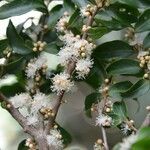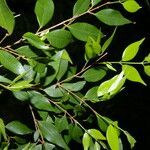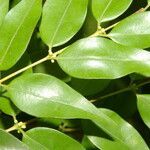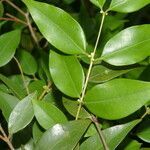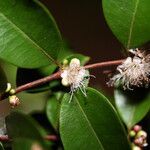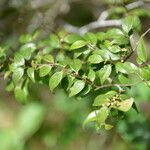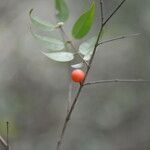Shrubs or small trees 2-10 m. high. Trunk 3-25 cm. in diameter, covered with a tight smooth light-brown exfoliating bark that is practically indistinguish-able from that of its common associate Calycolpus (cf. I. M. Johnston, loc. cit. 1949). Twigs densely foliate, the internodes 1-2 cm. long, at first puberulous, soon glabrate. Leaves elliptic-to lanceolate-oblong or lanceolate, long-acuminate to caudate at the apex, acute at the base, 2-5 (-7) cm. long and 1.0-2.5 cm. wide, chartaceous, at first pubescent on the margin and midrib, soon glabrate, the midrib flat above, prominent beneath, the lateral nerves numerous, delicately prominulous to nearly obsolete on both sides, the marginal nerve 0.5-1.0 mm. within the margin; petiole slender, 2-5 mm. long. Flowers glomerate, 2-5 together. Receptacle glabrous, about 1.5 mm. long, at last circumscissile above the ovary. Sepals 4, imbricate, about 1 mm. long, deciduous with the receptacle. Petals obovate, fimbriate, slightly longer than the sepals. Ovary glabrous outside. Berry globose, 8-15 mm. in diameter, 1-seeded, edible. Embryo homogeneous; radicle broadly adnate.
More
A small evergreen tree. It grows 15 m high. The bark is pale and smooth. The leaves are simple and deep green. They are 9 cm long. They are sword shaped and with a long point. The flowers are white and showy. They are almost without stalks. There are 4 fringed petals and a clump of golden stamens. The fruit are small and yellow with a sweet aromatic pulp. They can be red. They are 10 mm across. They have one or two seeds.
Evergreen shrub or small tree 3–4.5 m tall with reddish brown branchlets, puberulous when young; bark flaking.. Leaves elliptic-lanceolate, 2.5–8 cm long, 0.8–3 cm wide with slender attenuate apex with sharply acute tip; petiole 3 mm long.. Flower clusters subsessile.. Stamens ± 75.. Fruit orange to dark red or blackish red, globose or ± oblate-spheroid, 0.8–1.6 cm diameter.
